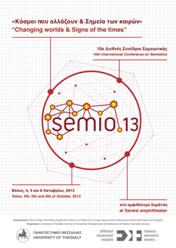Longing for the Past: the Nostalgic Semiosphere
Massimo Leone
Department of Philosophy, University of Torino
Andean language Aymara, as described in a 2006 seminal article by cognitive scientist Rafael Nunez and linguist Eve Swetseer, reflects a peculiar conception of time. Speakers of this idiom call the future “qhipa pacha/timmppu”, which means “back or behind time”, and the past “nayra pacha/timpu”, meaning “front time”. They conceive of the past as something that is in front of them, and of the future as something that is behind them. Their conception of time is spatially oriented: the past is already known, so it lies in front of everybody’s eyes, while the future is still unknown, out of anybody’s vision.
Cultures have diverse conceptions of time. But these vary diachronically too: the future is not what used to be. Under the pressure of ruinous socio-economic conditions, most European cultures are currently looking at the future with different eyes. Like the Aymara, they don’t see it anymore as something that is ahead of them, to be seized, grasped, and conquered, but as something that, mysteriously, lies in the past, hidden in potential paths that history never took. Aborted threads of collective life, they linger in an invisible limbo, unfathomable to all. Symmetrically, the past has become, for many Europeans, a lost, distant harbor, to be longed for in search of existential appeasement.
Wedged between an invisible future and a vanished past, Europe today revels in nostalgia. Coined in 1688 by Swiss physician Johannes Hofer to designate a pathological longing for distant homeland, the word “nostalgia” was soon rearticulated temporally, to refer to a lost époque one yearns for as one’s home.
Nostalgia is not a new topic for semiotics. Emotion essentially stemming from absence, it epitomizes the semiotic mechanism: semiosis is the ontological result of something staying for something else, but nostalgia is the emotional result of it. Essential figure in Greimas’s structural outlook on passion, umbrella-concept in Baudrillard’s mourning of reality behind the simulacra, key notion in Culler’s and Frow’s dissection of the semiotics of tourism, nostalgia has become a buzz word in both critical and marketing studies, the former trying to unveil beneath it the foundations of Heideggerian ontology or the contradictions of post-modern society; the latter, seeking to exploit nostalgia as the last Trojan horse into the agency of the consumer.
On the basis of copious and manifold literature on nostalgia, the conference will take an unexplored direction: can one talk, today, of a nostalgic semiosphere in Europe? Where hipsters, vintage furniture, and retro TV channels are nothing but symptoms of an emerging mentality? And as young Europeans strain in nostalgia for a distant, glorious, but imaginary past, how is nostalgia elsewhere shaping the approach of the new economies to the future? Why do Italian, Spanish, and Greek youths seem paralyzed by nostalgia for a past they never lived, while at the other side of the world young Chinese find in nostalgia for an imaginary but lost Shanghai the force to look ahead and build a prosperous future? Aren’t we maybe labeling as ‘nostalgia’ distinct cultural mindsets? How many kinds of nostalgia are there, and how do they shape our perspective on time and desire?



